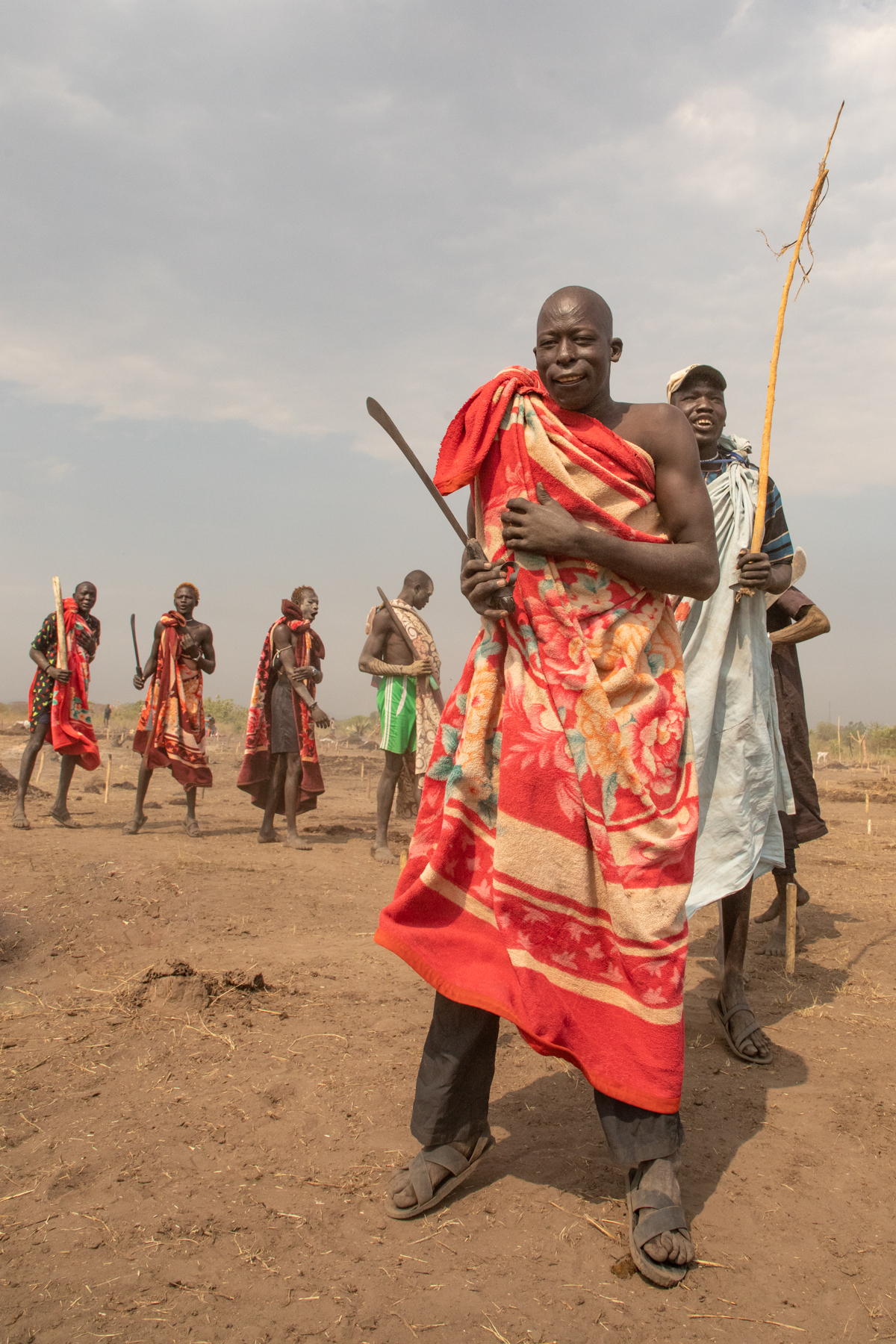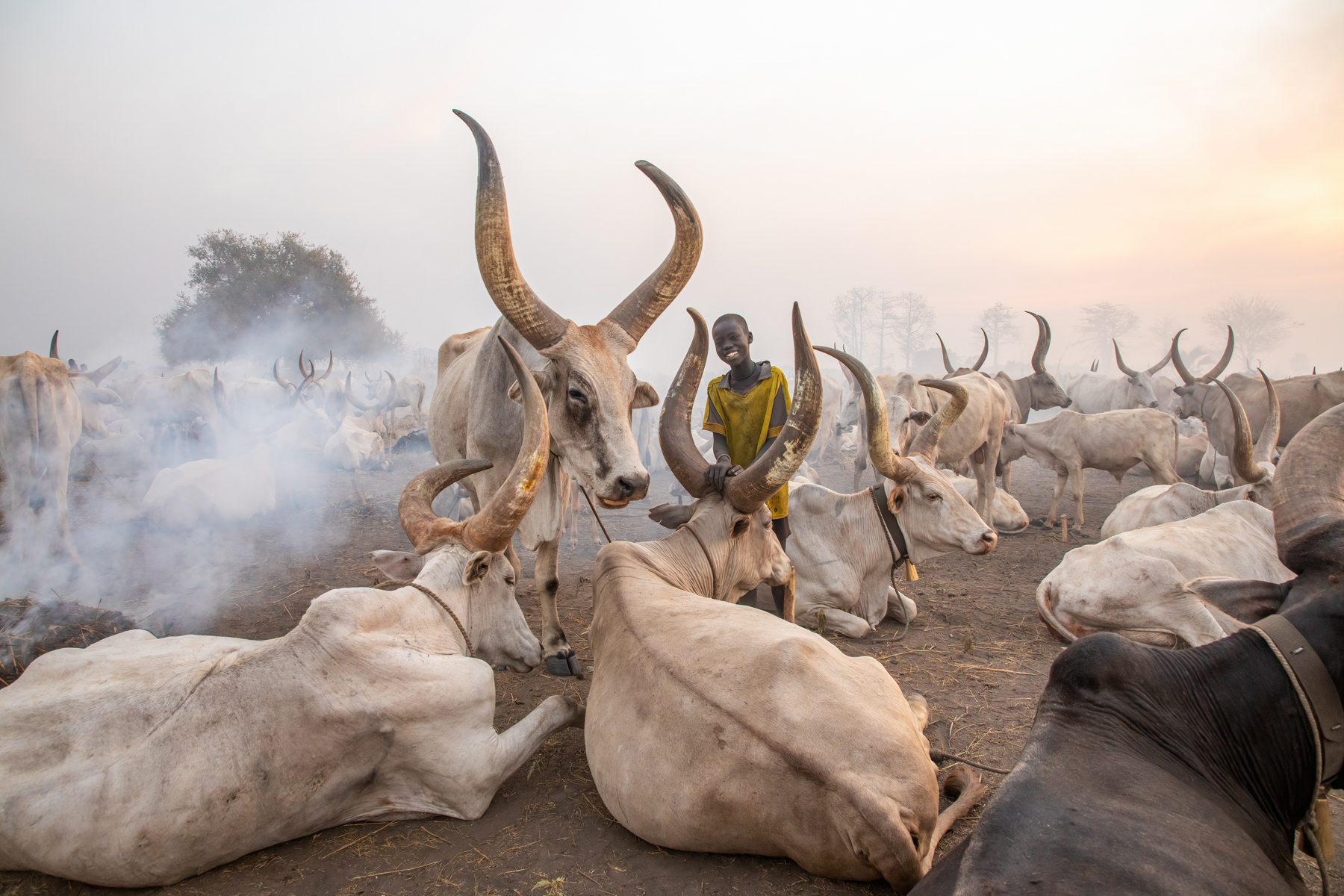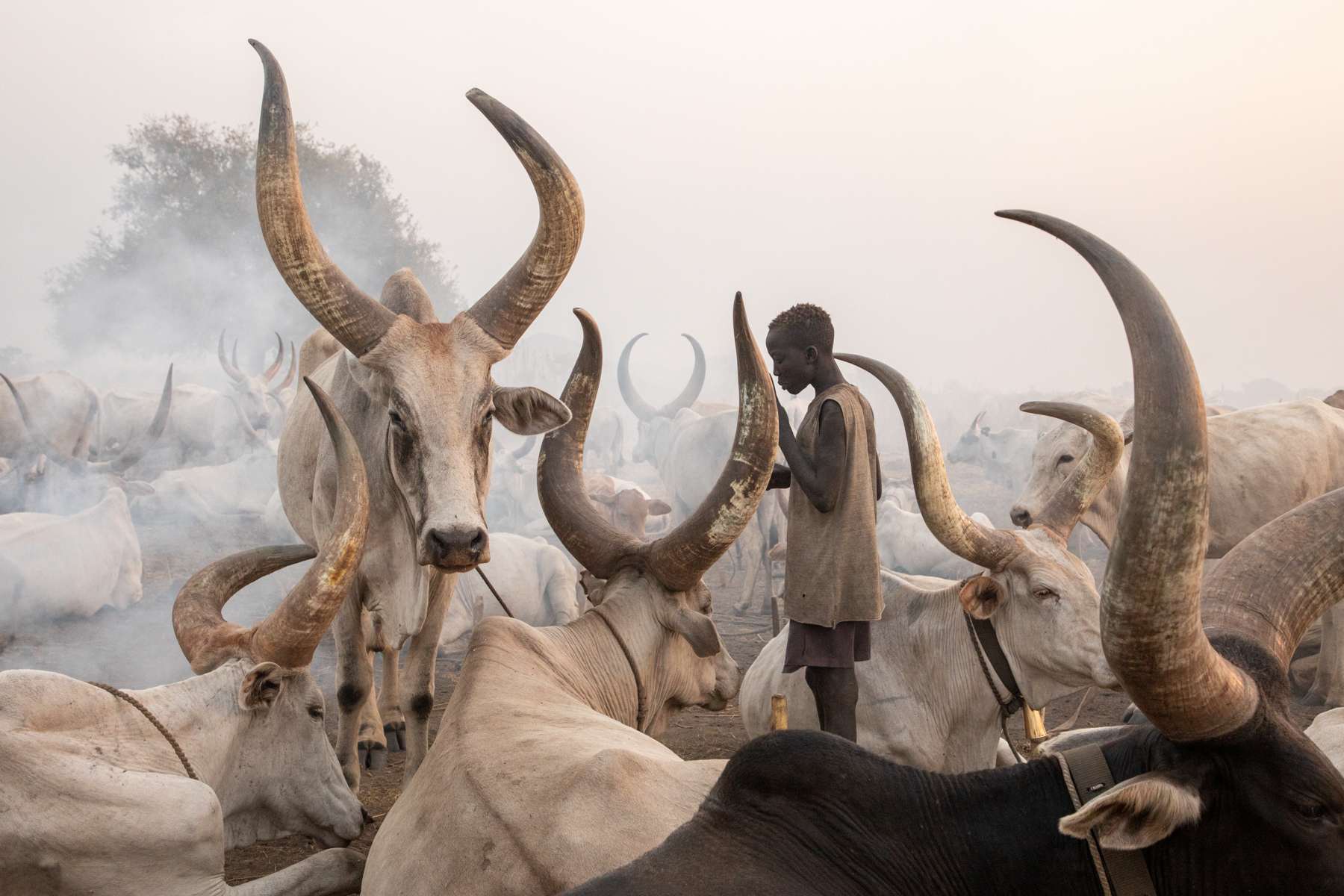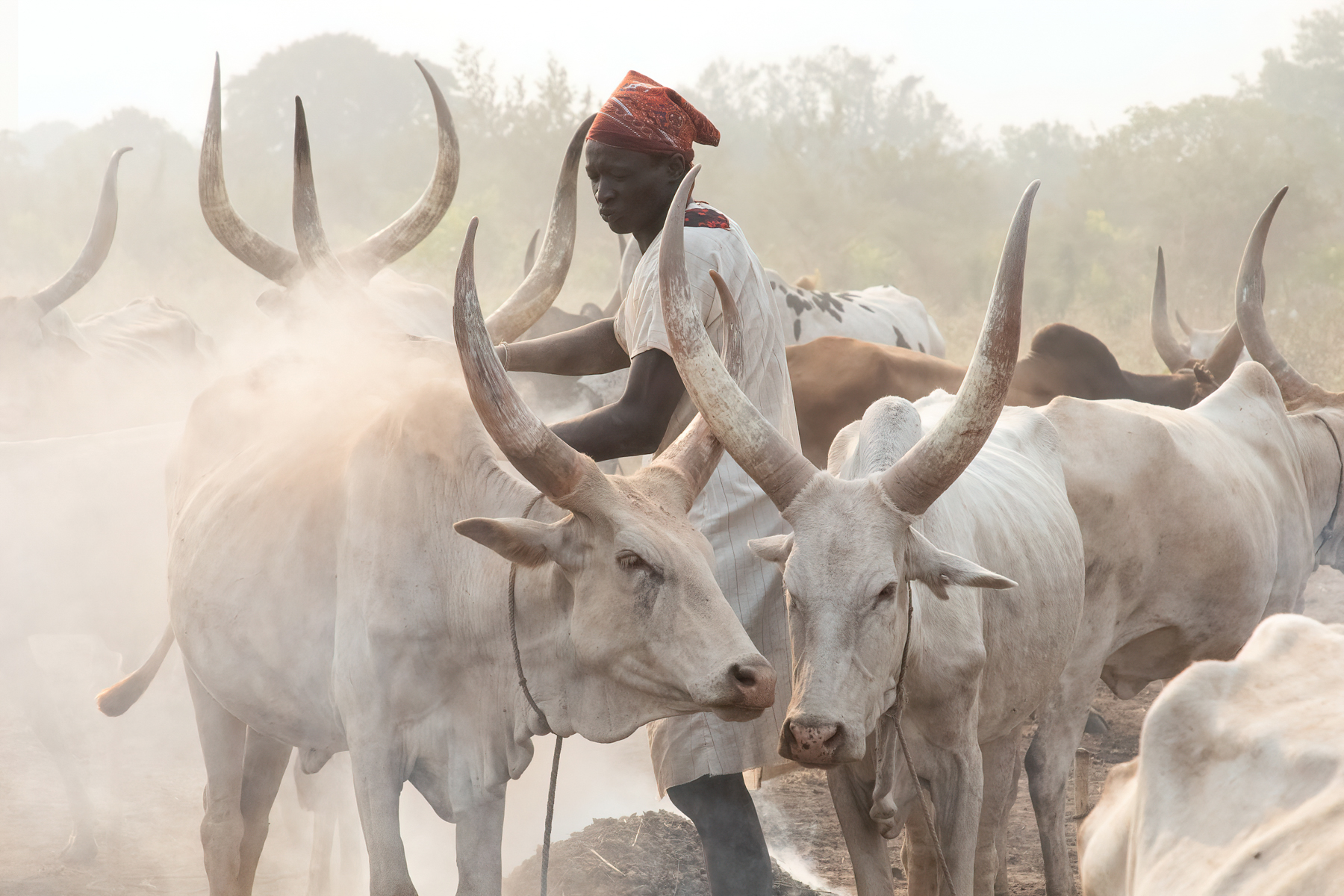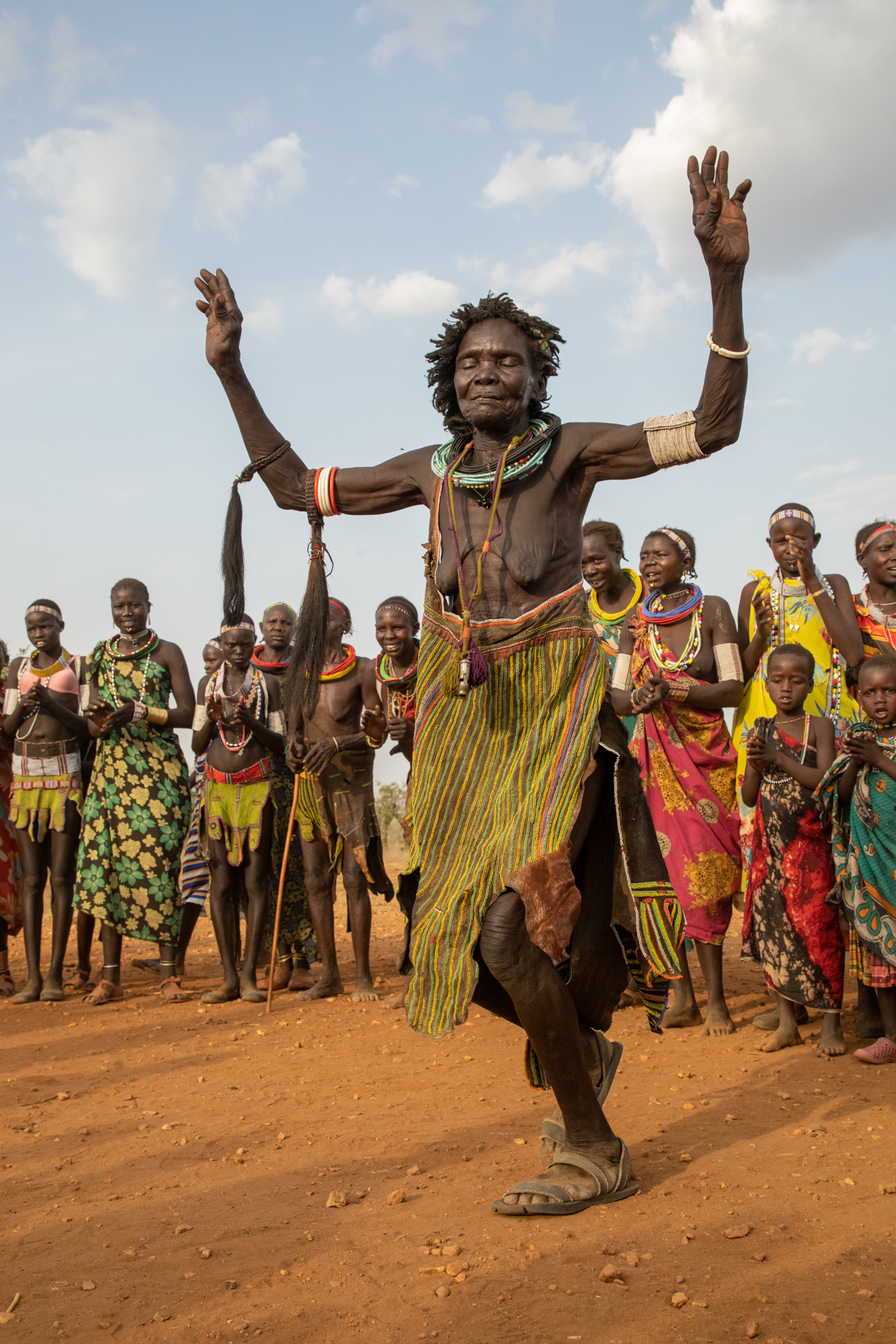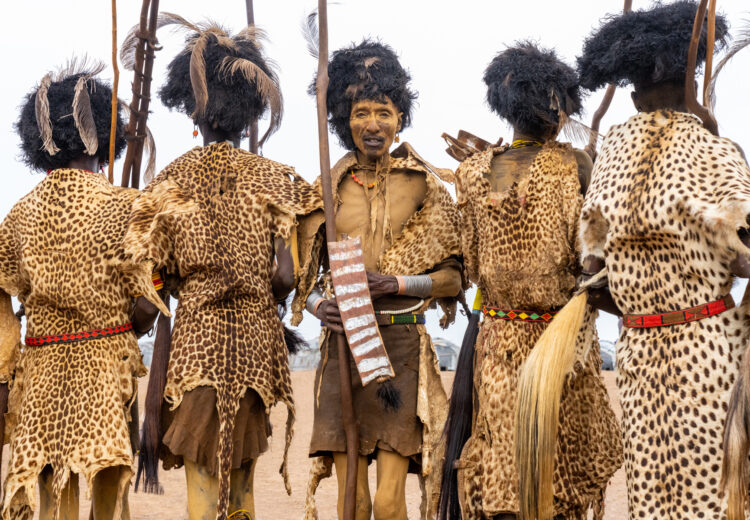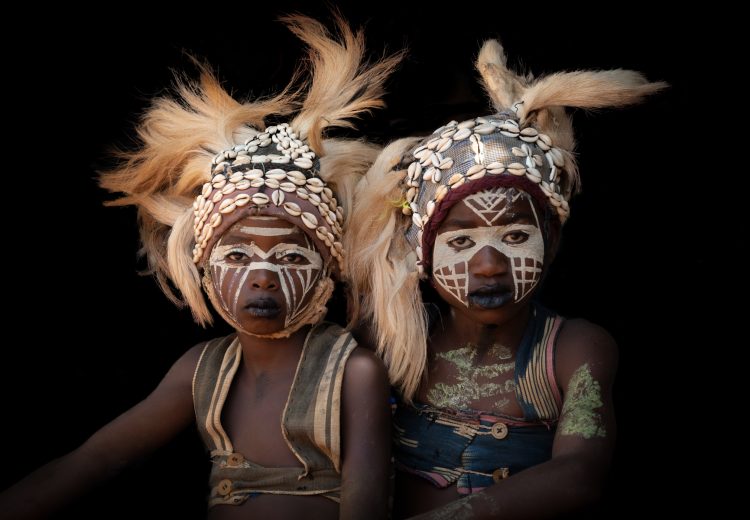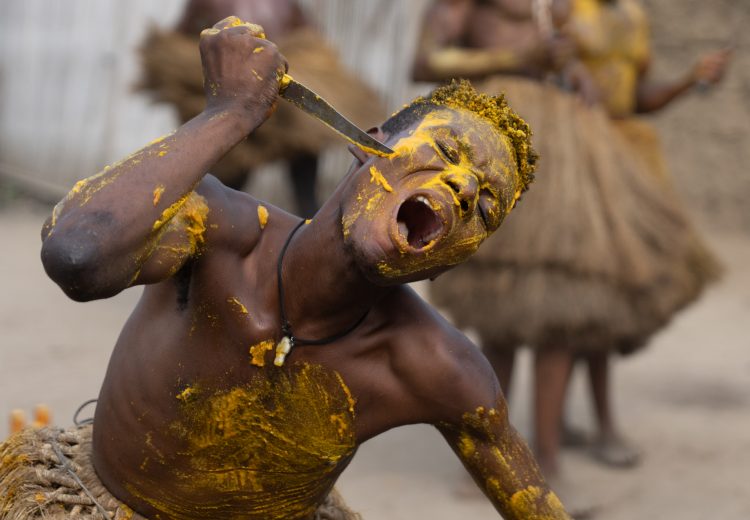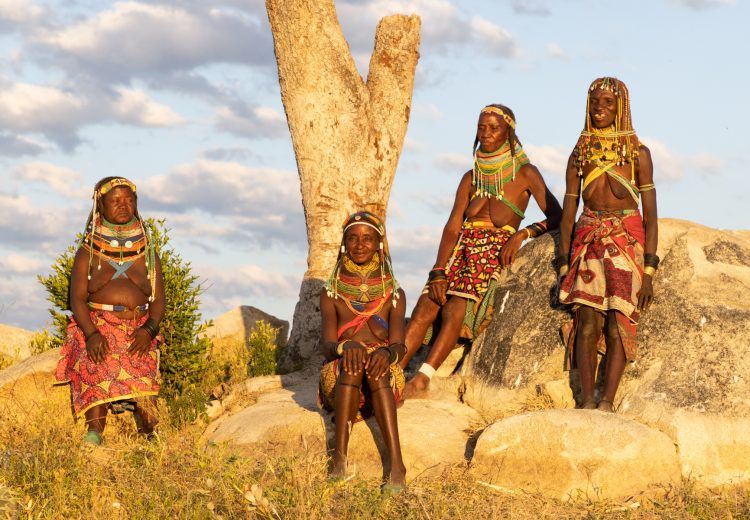South Sudan
SOUTH SUDAN: TRIBAL WONDERS OF THE WHITE NILE


















































































A Mundari boy poses next to his favourite cow in camp (image by Inger Vandyke)

Toposa women wear such beautiful decorations as their daily attire (image by Inger Vandyke)

A Toposa woman sitting at the entrance to her Ekore, a stilted granary of her people (image by Inger Vandyke)

Runes held in the ancient hand of Yolanda, a Lotuko witch (image by Inger Vandyke)

A Toposa family gathers to butcher a slaughtered goat (image by Inger Vandyke)

A Toposa woman takes a break from preparing mud and dung to line an Ekore granary (image by Inger Vandyke)

A Mundari woman tethers her cow in her cattle camp (image by Inger Vandyke)

When a Laarim woman is in mourning she will wear this dress for 39 days after the passing of a loved one (image by Inger Vandyke)

Athletic poses of dancing Toposa women during a ceremony of Meriye (image by Inger Vandyke)

A Mundari girl milks her cow as part of her early morning chores (image by Inger Vandyke)

Goats run past the huts of a typical Toposa village (image by Inger Vandyke)

Scarification and beautiful jewellery adorn the body of a young Toposa girl (image by Inger Vandyke)

Portrait of a young Mundari girl in remote South Sudan (image by Inger Vandyke)

Traditional Mundari scarification is a 'V' shape on the foreheads of Mundari people (image by Inger Vandyke)

Portrait of Lokom, a Toposa man, standing in his village (image by Inger Vandyke)

Portrait of a young Mundari boy at sunrise (image by Inger Vandyke)

Beautiful Ekores, or traditional Toposa stilted granaries are a classic example of African vernacular architecture (image by Inger Vandyke)

A group of Mundari men dancing a traditional Yanguera (image by Inger Vandyke)

A lead woman dancer of Laarim girls dancing a Nakeku in their village (image by Inger Vandyke)

Dancing Mundari men led by the smiling Malik, one of the best dancers of all (image by Inger Vandyke)

A group of Toposa men performing an impromptu Nyakwomoa, the dance of men normally reserved for Toposa weddings (image by Inger Vandyke)

A Toposa woman breastfeeds her child while she works to line the inside of an Ekore, or stilted granary, before the rains arrive (image by Inger Vandyke)

A young boy stops and smiles aside the gigantic Ankole Watusi cows of the Mundari people (image by Inger Vandyke)

The beautiful layered roofs of Toposa huts (image by Inger Vandyke)

"Would you like to buy some beer?" - a local Toposa bottle shop! (image by Inger Vandyke)

Beautiful smiling Nalit, a Toposa girl in remote South Sudan (image by Inger Vandyke)

Wild leaps into the air during a Meriye dance of Toposa people (image by Inger Vandyke)

Malik in action! (image by Inger Vandyke)

Dung carrying is an integral part of life for Mundari children. The dung they collect is used as fuel for fires at night (image by Inger Vandyke)

Stella, a young Lotuko girl, grinding dried Okra in the steep hillside grinding pits above her village (image by Inger Vandyke)

A young Mundari boy gathers dung to be dried for fires in his camp (image by Inger Vandyke)

The night watchman. A Mundari man surveys his cattle at the camp on sunset (image by Inger Vandyke)

Massaging ash into the pelts of cows is a typical morning activity of the Mundari cattle camps (image by Inger Vandyke)

Toposa decoration is stunning! (image by Inger Vandyke)

A pretty Mundari girl takes a break after milking her cow in the morning (image by Inger Vandyke)

A Mundari drummer blesses the cowskin of his cylindrical drum to prepare for a ceremonial dance (image by Inger Vandyke)

The Mundari revere their Ankole Watusi cows, often stopping to stroke their horns, pick ticks off them and massage them (image by Inger Vandyke)

A beautiful Toposa woman stands in her village in remote South Sudan (image by Inger Vandyke)

Portrait of a beautiful Toposa woman and her baby (image by Inger Vandyke)

Naguri with her pretty Laarim jewellery (image by Inger Vandyke)

Portrait of Lotu, a beautiful Toposa girl we met on our walk in remote South Sudan (image by Inger Vandyke)

A Toposa woman and her young daughter in front of their hut in South Sudan (image by Inger Vandyke)

A young Mundari boy pauses in contemplation, looking at his cows (image by Inger Vandyke)

Portrait of a young Mundari boy covered in ash (image by Inger Vandyke)

A Mundari boy carrying his stick through camp. Mundari children will cover themselves in ash from fires to protect their skin (image by Inger Vandyke)

For the Mundari, dances like the Yanguera are an emotionally charged event (image by Inger Vandyke)

The lead female dancer at the Toposa Meriye ceremony (image by Inger Vandyke)

A path through the Ekores of a Toposa village (image by Inger Vandyke)

Toposa women dancing a Meriye stop to pose in the same stances as their cows (image by Inger Vandyke)

Portrait of Supaida, a young Lotuko girl in the wooded entrance to her village (image by Inger Vandyke)

A Mundari man on his bed with his toothbrush. The Mundari prize their cows so much that they will even sleep beside their favourite cow each night (image by Inger Vandyke)

A group of Laarim women carry bundled roofing materials to their village. Laarim women are responsible for all aspects of home construction (image by Inger Vandyke)

Malik poses like a cow during the Yanguera dance of Mundari people (image by Inger Vandyke)

Nawuyo. She was the leader of the dancing Laarim girls we met in the Kimotong mountains of South Sudan (image by Inger Vandyke)

"No one likes this cow! He butts people!" explains Mario, one of the Mundari cattlemen of our camp (image by Inger Vandyke)

A young Mundari boy wanders through his cattle camp at sunrise (image by Inger Vandyke)

The bark of an ancient tree in a Lotuko village (image by Inger Vandyke)

Portrait of Mochi holding his traditional 'Tung' or musical horn made from the cowhorns of Mundari cattle (image by Inger Vandyke)

An elderly Toposa woman in the market at Kapoeta (image by Inger Vandyke)

Mundari children are often tasked with looking after young Ankole Watusi cows (image by Inger Vandyke)

A Mundari woman drags a hesitant calf to be tethered (image by Inger Vandyke)

Laarim women carrying roofing materials in the foothills of the stunning Kimotong Mountains of South Sudan (image by Inger Vandyke)

Strike a pose! A Toposa woman stops for our cameras during the Meriye dance of her people (image by Inger Vandyke)

Malik stops to pose during the Yanguera, a traditional dance of the Mundari people (image by Inger Vandyke)

Springing into the air is a common act of dances in the Toposa people (image by Inger Vandyke)

A morning massage of Ankole Watusi cows using ash from a nearby fire that burned overnight to keep cattle free of biting insects (image by Inger Vandyke)

Beaded detail of a Nyadol, the front skirt worn by Toposa women for ceremonies (image by Inger Vandyke)

A Mundari boy with two of his cows (image by Inger Vandyke)

Heart and soul gets poured into the ceremonial dances of the Toposa people (image by Inger Vandyke)

Beautiful, smiling Lotu (image by Inger Vandyke)

On cold mornings Mundari wrap themselves in brightly coloured blankets to stay warm (image by Inger Vandyke)

It's hard to understand the true size of the Mundaris' cattle until you see a young person standing beside one! (image by Inger Vandyke)

The incredible detail of Toposa decoration where every piece has a special meaning for the woman wearing it (image by Inger Vandyke)

Mundari cows enjoy their morning massages so much that you can see their eyes closing in ecstasy! (image by Inger Vandyke)

A Mundari man covers himself in ash for decoration (image by Inger Vandyke)

A Laarim woman carrying thatched grasses to cover an animal enclosure in her village (image by Inger Vandyke)

In the peak of the dust and smoke season Mundari cattle camps are shrouded in an ethereal haze (image by Inger Vandyke)

Portrait of Elia, a traditional Toposa man with his facial scarification (image by Inger Vandyke)

Mundari people will often hold their arms up to form the shape of their cows when you photograph them! (image by Inger Vandyke)

A young Mundari boy takes a break from collecting dung in the cattle camp at sunrise (image by Inger Vandyke)
|
Thursday 6th February –
Thursday 20th February 2025 Leaders: Inger Vandyke and local cultural guides |
15 Days | Group Size Limit 5 (full) |
|
Saturday 6th February –
Saturday 20th February 2027 Leaders: Ingrid Koedood and local cultural guides |
15 Days | Group Size Limit 5 |
South Sudan. It is Africa’s newest country. Despite having gained its independence just over twenty years ago, South Sudan is home to some of the most ancient and diverse cultures in all of East Africa.
Flying over South Sudan on a clear day it is fascinating to watch a series of rugged mountain ranges unfold beneath the plane and if you look carefully you may catch a glimpse of isolated villages dotted in this incredible landscape. These villages are home to some of the most untouched and beautiful people who live in finely sculpted traditional homes that are some of the finest examples of African vernacular architecture in the region.
Travelling in this remote part of Africa is a real adventure. The youthful nature of the country and lack of infrastructure lends South Sudan a frontier-like feel, yet for photographers wishing to journey off the beaten path, travelling in this young nation is a richly rewarding experience of highly decorated people still living much the same way they have for centuries.
Our expedition in South Sudan journeys to remote villages to meet six different, yet startlingly beautiful, groups of African people including the Lopit, Peri, Toposa, Jiye, Laarim and Mundari.
LOPIT
Deep in a remote part of Eastern Equatoria, the spectacular Lopit people reside in the Lopit Hills region near the border of Uganda with South Sudan. They are Eastern Nilotic people who practice agriculture as well as rearing livestock on the mojntain slopes. Alongside raising livestock they are known to harvest honey and shea butter nuts.
Spanning just six sub-communities, these lesser known people of South Sudan celebrate important events of life through dance and ceremonies that are performed for initiations, funerals, weddings, the elderly or a successful hunt. The transfer of knowledge in Lopit culture uses songs, poetry, drama and music that expresses their feelings and emotions.
Marriage begins with courtship and then the girl elopes with her boyfriend. When they return home the dowry is settled and she goes to her new home. The transfer of power to the younger age-set happens every 25 years in a ceremony called Hifira. This is when the village administration and authority over community affairs is handed to the next generation.
One of the most spectacular celebrations performed by the Lopit is a funeral, where young Lopit warriors will don huge headdresses fashioned out of cowrie shells, ostrich feathers and native grasses, and wear a traditional dress fashioned out of Colobus skins before they dance in circles out of respect for a recently deceased person.
TOPOSA
The handsome and beautifully decorated Toposa people of South Sudan belong to the Karomojong cluster of African people which includes the Turkana people of Kenya, the Nyangatom people of Ethiopia, the Karomojong people of Uganda and the Dongiro and Jiye people of remote southeastern South Sudan. Living deep in the Ilemi Triangle, a secluded geographical corner between South Sudan, Kenya and Ethiopia, the Toposa are proud, statuesque and friendly. Visiting their villages is like stepping into another world. Built by Toposa women, their curious stilted granaries called Ekores are positioned in communal stands between pretty, sculpted roundhouses. As we explore Toposa villages on foot it is possible to see women preparing Ekores for the rain using a mix of mud and dung or we may encounter them stitching beads by hand to their beautiful Nyadols, or goatskin skirts.
To date, the Toposa people have largely resisted a lot of the influence of our modernised, outside world. Their economic and social life revolves around herding cattle, camles, donkeys, goats and sheep. Boys are first given goats and sheep to care for, then after they come of age, they are given the role of taking care of cattle. The Toposa have always competed with neighbouring tribes for water and pasturage. Traditionally they engaged in the ivory trade but now that has been banned, they pan for gold and other precious minerals in local streams.
During our stay with the Toposa we will experience an afternoon of traditional dance that will include the Meriye, or dance of women. This highly athletic dance features beautifully adorned women dancing in circles while performing the high leaps into the air that are so characteristic of other dances in Turkana cultures. If we are lucky the Toposa women may also be joined by men performing a warrior dance of Nyakwamoa where they will leap into the air waving spears and shields as a show of strength and superiority over their neighbouring tribes.
JIYE
As we travel into more remote regions of Eastern Equatoria, we will visit several communities of the beautiful Jiye, who are a sister culture of the Toposa. Sharing the same stunning facial and body keloidal scars of Toposa people, the Jie also practice specific lip piercing and the women adorn themselves with beaded, semi-circular crowns, multi-stranded bead necklaces, brass bands and nose rings. These beautiful beaded decorations have colours that tie a Jie woman to the clan of her husband.
Visually their villages resemble those of the Toposa with their pretty stilted granaries (Ekores) and roundhouses, yet the Jie remain geographically isolated in a region of rolling hills and golden grasslands. They rarely visit towns like Kapoeta due to the distance they need to travel to purchase necessities so we will spend two nights living alongside family communities of these beautiful people in their villages at the base of the remote Boma Plateau in the Kathangor Hills.
LAARIM
At the foothills of the spectacular Kimotong Mountains of Eastern Equatoria live the Laarim, a smaller ethnic group of people who practice the most intricate scarification we will see on our tour. Considered to be some of the most traditional people in South Sudan, the Laarim live in beautiful villages at the foothills of the rugged Kimotong, a mountain range that is home to troupes of Olive Baboons, Rock Hyraxes and many species of birds. The steep granite peaks of the Kimotong pierce the sky above Laarim villages almost watching over them like stony sentinels and as we walk the undulating paths from village to village we will see many desert rose succulents while being shaded by large Acacias and stands of Doum Palms.
Perhaps as a direct response to their stunning landscape, the Laarim people have a highly valued aesthetic that is reflected in everything they do. From the decorations on their homes that include animals bones and shells, to the kitchen utensils like wooden spoons and gourds which are decorated with beads, beauty underpins the entire world of Laarim people.
The crowning glory of this elaborate tradition is the stunning decoration of Laarim women. Starting with their many-patterned intricate keloid scarification which covers their faces and sometimes their entire bodies, Laarim women accompany this with beautiful piercings and beaded jewellery alongside pretty multi-layered floral skirts, colourful socks and striped, sari-like dresses. This stunning dress style is only ever abandoned when they become a widow, in which case they dress down with a simple adornment of a white dress and headdresses and armbands fashioned out of dried palm fronds and vines.
In this fairy tale land of attractive people and sculpted villages we may meet elderly Laarim women smoking tobacco from long pipes they call ‘Ijoo’. Between watching young Laarim boys shepherding their goats and sheep we will see small children seeking Doum palm seeds which they eat like a rusk for breakfast.
A highlight of our time with the Laarim will be to watch a dance of Kuduma, or the Jackal Dance and another called Nakeku where Laarim girls dance to attract young men. Taking place at sunset or sunrise, these dances are usually led by a head girl who makes the first moves, prompting the entire group to follow. It is really a magical experience watching these beautiful girls dancing in such a dramatic and ruggedly beautiful landscape.
MUNDARI
Statuesque and incredibly strong, the Mundari people are one of the most special remaining tribal groups left in all of Africa.
Characterised by unique facial scarring that features three parallel lines pointing downward in a ‘V’ shape across their foreheads, the Mundari really are the traditional warriors of the White Nile.
The Mundari’s world is centred around looking after their magnificent Ankole Watusi cows which are handled by people from the time they are born until the time they die. So special is this relationship that a Mundari man will often sleep beside his favourite cow and if you gently ask someone to take their photo, they will hold their arms in the air in the same position of the horns of their beloved cow. The Mundari nomadically herd their cattle to places that are close to grazing and water sources, setting up cattle camps which are a frenzy of activity from dawn to dusk each day. A typical Mundari day starts with dusting their cows with ash from fires that burned overnight to keep both cows and animals free of mosquito bites. The ash from fires helps to protect Ankole cows from the harsh heat of the African sun. Young Mundari children will run around collecting milk from their favourite cow or freshly laid dung which they transport in buckets to special piles that are dried during the day for fire fuel. Some children will drink milk directly from the udders of cows while others will take a shower in the urine of a cow which acts as a sterilising agent and also as bleach for their hair! During the day, young men and women will take their cows out to feed and water for the day. As the sun gets lower they return and the children are tasked again with tethering their cows overnight. Women will then gather the dried dung to make fires for cooking, warmth and to repel biting insects. This is the Mundari cycle of life and it is at its most spectacular during the dry season where fire smoke and clouds of dust stirred up in the cattle camps create an almost ghost-like atmosphere, allowing for unrivalled photographic opportunities each day.
These hardy and resilient people are fascinating to learn about through our conversations around our camp. We will establish our expedition base right next to a cattle camp allowing enough free time to wander through the cows, meeting people and taking photos without rushing.
During our time with the Mundari we will visit unique villages known for their spectacular African vernacular architecture and also learn about the large black and white totem poles, their granaries and we will learn about traditional ritual scarification and bodily decoration.
Our expedition has been timed to ensure we are in South Sudan at the peak of the heat and dust season in Mundari camps and our longer time with these people will allow us to hopefully see a traditional wrestling match or the dance of Yanguera, which is performed by young Mundari men to attract a wife.
Why travel to South Sudan with Wild Images
Right now a number of photographers and photography touring companies offer tours through South Sudan. Our expedition tour leader Inger Vandyke is one of the most culturally skilled photographer guides operating in Africa. She pioneered our tour to South Sudan in 2021 and has designed this unique expedition to feature several rarely seen ceremonies that take place in isolated communities of South Sudan. It is the only tour of its kind to feature photography opportunities of these magnificent celebrations.
Our tour is longer than most on offer because we believe that the best images come from the photography of people in a two-way situation. We encourage our guests to chat to local people, laugh with them, engage with them and simply enjoy the experience of being immersed in their world.
Accommodation & Road Transport
The hotel we use in Juba is a good standard with hot showers, air conditioning, wifi and ensuite facilities. During the expedition, we will stay in simple camps. There will be 2-man tents (but each person can have their own tent: couples may prefer to use one tent for luggage) and a dining table with chairs. All meals will be provided and cooked by our support staff. Washing facilities are a bowl of cool water, taken in your tent and toilet facilities are a lone walk into the wilds or in shared facilities. Your camp will be set up and taken down for you by our camp staff in each place.
The transport for the South Sudan expedition will be by 4×4 vehicles. Roads in South Sudan are only reasonable in the cities, the few tarred highways are usually dotted with potholes. For much of our journey we will be on dirt roads and tracks so our transport is in 4WD expedition vehicles.
Walking
The walking on this tour is mostly easy. To visit the Pari people may require a short hike up a hill. Walking between Laarim villages is over gently undulating ground.
Climate
The weather in South Sudan will be hot. There is likely to be a mixture of sunny and overcast conditions. Rain is unlikely.
Photographic Equipment
For most photography of the people in South Sudan, a travel lens of around 24-105mm on a full-frame DSLR or mirrorless body will be essential. A wide-angle lens of around 16mm or smaller will be perfect for working with people inside smaller huts.
If you prefer to photograph people from a distance, then please consider bringing a larger zoom or telephoto lens. It is our experience that sometimes people can feel a bit intimidated by large cameras and lenses so you may wish to bring a smaller sized zoom lens like a 100-400mm which doesn’t appear as intimidating as a large fixed focal length telephoto lens. Such a lens can also be useful for the ceremonies we will attend as you will often be standing in a crowd and a longer lens will allow you to shoot past other onlookers.
If you bring a good quality bridge camera instead of a DSLR or mirrorless it will be best if it has an optical zoom of 18-20x or more, combined with a reasonable wide-angle at the other end of the zoom range.
If you have a phone or tablet that can be used for photography, you may find these quite useful around people. Similarly, if you have a Polaroid camera like the Leica Sofort or an Instax Mini, these are wonderful to have on hand when you spend time with tribal people. If you decide to bring one of these, please bring lots of film with you as the photographs you produce will be quite popular!
Please note the use of drones in South Sudan is strictly forbidden.
If you would like to talk over suitable equipment, please contact our office. We will be happy to advise.
Photographic Highlights
- The only tour in South Sudan that offers a myriad of ceremonies, many of which are seen by few outsiders
- Visit the remote Lopit and Peri people, just two in a cast of six that also includes the Jiye, Toposa, Mundai and Laarim
- A true adventure in the frontier-like countryside of Africa’s newest country
- Photograph the spectacular Mundari people in their mesmerisingly beautiful cattle camps at the peak of the 'dust season'
- Explore the beautiful body scarification and decoration of the Laarim, Toposa and Jiye people
- Travel to the remote Boma Plateau in the Kathangor Hills to meet isolated communities of beautiful Jiye people
- Traverse three rugged granite mountain ranges, the Liria, Ileu and Kimotong which are home to spectacular tribal villages and wildlife including nesting Ruppells Vultures, rock hyraxes, olive baboons and bushbuck
- Travel with a highly experienced team who know the villages we will visit intimately
- Experience lively and fascinating tribal dances including the Nakeku of the Laarim people, the Meriye in the Toposa people and the Yanguera of the Mundari
- Enjoy a ceremony with the remote Peri people as they show off their traditional dress and music
- Visit the lesser known Lopit people to learn about their spectacular ceremonies and intricate tribal decorations
- Our leader at Wild Images has over three decades of experience in travel and leading expeditions in remote Africa
OUTLINE ITINERARY
- Day 1: Arrive in Juba in time for dinner by the side of the White Nile and an overnight stay
- Day 2: After finalising our travel permits for the expedition we will fly from Juba to Kapoeta and then drive to the Boma Plateau to visit the Jie people
- Day 3: A full day of photography in Jie communities
- Day 4: Drive southwards towards Kapoeta and visit the Toposa people
- Day 5: A full day of photography with Toposa people
- Day 6: Drive from Toposa area to the Kimotong Mountains to visit Laarim people
- Day 7: Full day of photography in Laarim villages
- Day 8: Today we will drive a long distance to reach the remote Lopit people, arriving in time for sunset photographs in their villages
- Day 9: A full day of photography with Lopit people including joining a traditional ceremony and photography around villages
- Day 10: Early morning transfer to the Peri people for village photography and an evening ceremony
- Day 11: Final photos with the Peri before we pack up our vehicles to make the journey back to Juba.
- Day 12: Today we will drive out to the Mundari cattle camps, arriving in time to spend our first afternoon taking photos until sunset
- Day 13: A full day of photography with Mundari people
- Day 14: After a final morning of photography with the Mundari people we will return to Juba
- Day 15: The tour ends after breakfast in Juba
To see a larger map, click on the square-like ‘enlarge’ icon in the upper right of the map box.
To see (or hide) the ‘map legend’, click on the icon with an arrow in the upper left of the map box.
To change to a satellite view, which is great for seeing the physical terrain (and for seeing really fine details by repetitive use of the + button), click on the square ‘map view’ icon in the lower left corner of the ‘map legend’.
SOUTH SUDAN: TRIBAL WONDERS OF THE WHITE NILE PHOTOGRAPHY TOUR:
PRICE INFORMATION
South Sudan Photography Tour Prices: Tour prices in South Sudan are high given the local conditions, but there are reasons for this. In the first place, transport for tourism purposes is very expensive. South Sudan is a country with only a thin ‘meniscus’ of development that sits on an otherwise very undeveloped part of the world. Furthermore, and even more importantly, the country is quite rigidly controlled by costly road permits to travel and police at the checkpoints often require ‘extra fees’ which are unavoidable if we want to complete our tour! This combination makes for high prices.
Wild Images Inclusions: Our tour prices include the one way flight between Juba and Kapoeta, surface transportation, accommodations, meals and national reserve entrance fees. All photography, guide, village and driver donations and tips are included in the tour price. Since all camera equipment needs to be registered and paid for in South Sudan, we include registration for two camera bodies for each guest.
Deposit: 20% of the total tour price. Our office will let you know what deposit amount is due, in order to confirm your booking, following receipt of your online booking form.
TO BOOK THIS TOUR: Click here (you will need the tour dates)
2025: confirmed price £7840, $9990, €9540, AUD15880. Juba/Juba.
2027: provisional price £7840, $9990, €9540, AUD15880. Juba/Juba.
Single Supplement: 2025: £300, $390, €370, AUD620.
Single Supplement: 2027: £300, $390, €370, AUD620.
If you are travelling alone, the single supplement will not apply if you are willing to share a room and there is a room-mate of the same sex available. The small single supplement applies to the overnight stays in hotels in Juba. The tented accommodation on the main tour is the same cost for a single or twin share.
This tour is priced in US Dollars. Amounts shown in other currencies are indicative.
Air Travel To & From The Tour: Our in-house IATA ticket agency will be pleased to arrange your air travel on request, or you may arrange this yourself if you prefer.
SOUTH SUDAN: TRIBAL WONDERS OF THE WHITE NILE PHOTOGRAPHY TOUR: DETAILED ITINERARY
South Sudan Photography Tour: Day 1
Our South Sudan photography tour starts in the early evening in our Juba hotel where we will enjoy dinner on the side of the pulsing White Nile, one of the most iconic rivers in Africa.
South Sudan Photography Tour: Day 2
After breakfast and finalising our permits to travel we will fly to Kapoeta in Eastern Equatoria where we will meet our drivers who will take us to a remote corner of eastern Equatoria, home of the spectacular Jiye people, with their intricately beaded crown jewellery and bodily scarification.
South Sudan Photography Tour: Day 3
Today we will enjoy a full day of visiting Jiye communities for photography.
South Sudan Photography Tour: Day 3
As we pack up our camp, we will drive south to the Toposa region, arriving in time to visit our first Toposa villages doing photography of these beautiful people and their wonderful vernacular architecture, including their ‘Ekore’ stilted granaries. We may also see traditional dances including the feminine Meriya and hopefully Nyakwamoa, or the tribal dance of Toposa warriors.
South Sudan Photography Tour: Day 5
Today we will enjoy another full day with the Toposa people, wandering through their villages and taking photos.
South Sudan Photography Tour: Day 6
After a final morning of Toposa photography we will leave for the rugged and incredibly spectacular Kimotong mountains that are home to many villages of Laarim people. These soaring granitic peaks also feature huge stands of desert rose plants, whimsical Laarim huts, animal enclosures and traditional grinding pits at the foothills of these mountains. For centuries Laarim women have used these pits to grind grain and with luck we will watch them grinding grains while sometimes cradling their children in the warm stone.
South Sudan Photography Tour: Day 7
Today we will spend a full day exploring Laarim villages on foot, photographing their intricate and highly decorative bodily scarification and jewellery. With luck we may see traditional dances like Nakeku, or the coming of age dance for young Laarim girls.
South Sudan Photography Tour: Day 8
The next day we will travel out to the remote region of the Lopit people, who live close to the border of South Sudan and Uganda. We will arrive in time to explore the beautiful villages of the Lopit people on foot taking photos.
South Sudan Photography Tour: Day 9
Today we will spend a full day exploring Lopit villages for photography. We will also witness a simulated ceremonial dance for a Lopit funeral. This highly decorated dance involves Lopit men dressed in leopard skins, colobus skins and headdresses fashioned out of cowrie shells and ostrich feathers. As the most spectacular ceremony of our tour, this will be an absolute memorable highlight of our visit with these remote people.
South Sudan Photography Tour: Day 10
After a final morning of photography in the villages of the Lopit people we will drive through three spectacular mountain ranges back to Juba. We will also make a brief stop to view a prolific nesting site of Ruppell’s Vultures in one of the mountain ranges before we arrive in Juba for a much needed rest, shower, battery charge and dinner by the White Nile.
South Sudan Photography Tour: Days 11 to 13
Today we will embark on the final leg of our expedition to travel out to a remote cattle camp of the stunning Mundari people. We will establish our expedition base right alongside our camp where we will spend four magical nights learning about Mundari ways, attending a traditional dance and witnessing a wrestling match. As we enjoy numerous photography sessions with these amazing people, we will immerse ourselves in the Mundari world of worshipping their beautiful Ankole Watusi cows, watching children drink directly from their cows, young Mundari men sleep alongside them and we will enjoy the daily rituals of fire building, cattle caring and life amongst some of the most visually stunning people in all of Africa.
South Sudan Photography Tour: Day 14
After a final sunrise photography session with the Mundari we will pack up our expedition, say our final farewells and drive back to Juba where we will once again enjoy a wonderful, final dinner on the banks of the White Nile.
South Sudan Photography Tour: Day 15
Our tour ends today after breakfast and if time allows we may take a short visit into Juba to wander the alleyways of the city’s bustling street market before we are taken to the airport for our flight home.
South Sudan Photography Tour Report 2021
It’s quite something to arrive in Juba, the capital of the world’s newest country. After navigating the chaos of the airport, you are richly rewarded with dinner on the banks of the incredible White Nile. This is how our expedition began and, as we sat watching Palm Swifts gather in the fronds of the Doum […]
View Report
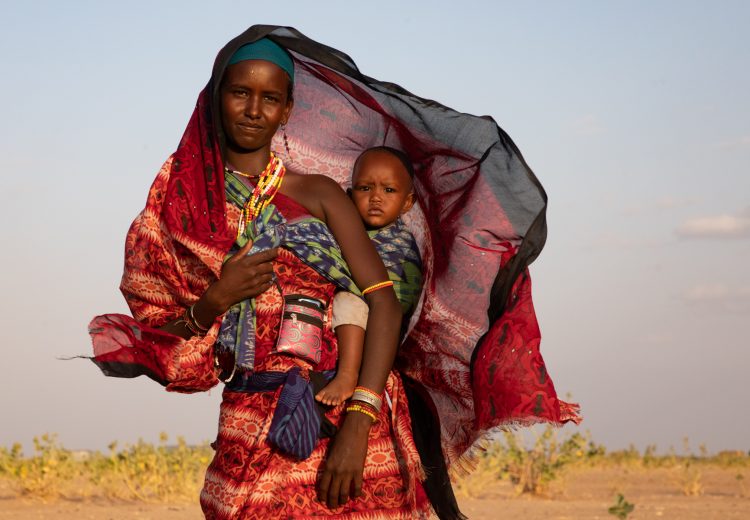
Kenya
August-September 2026




















